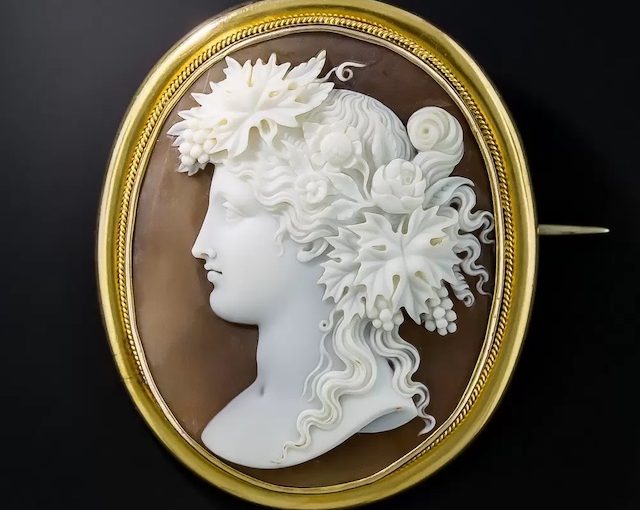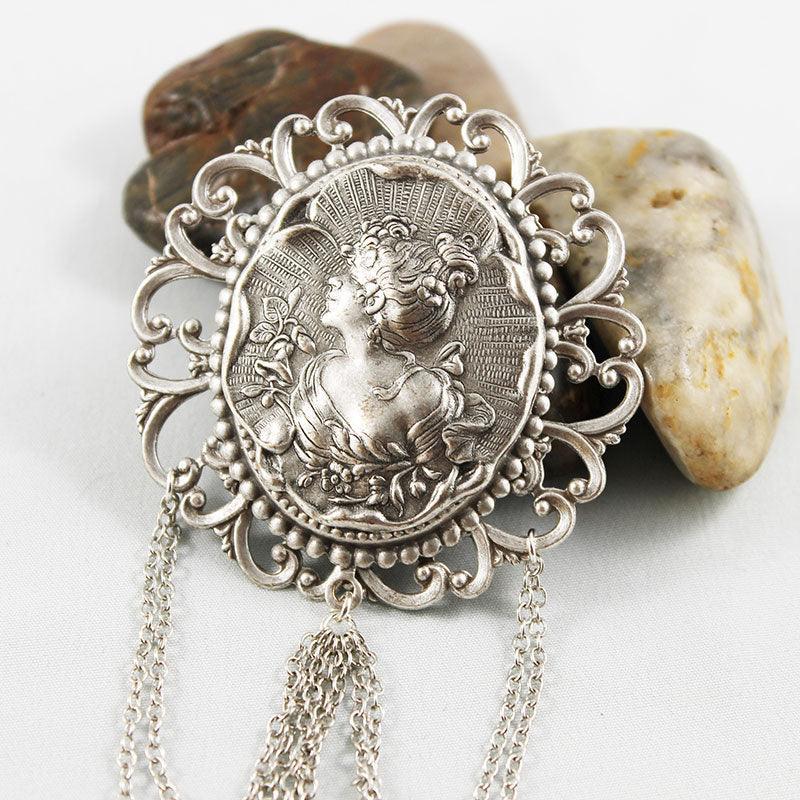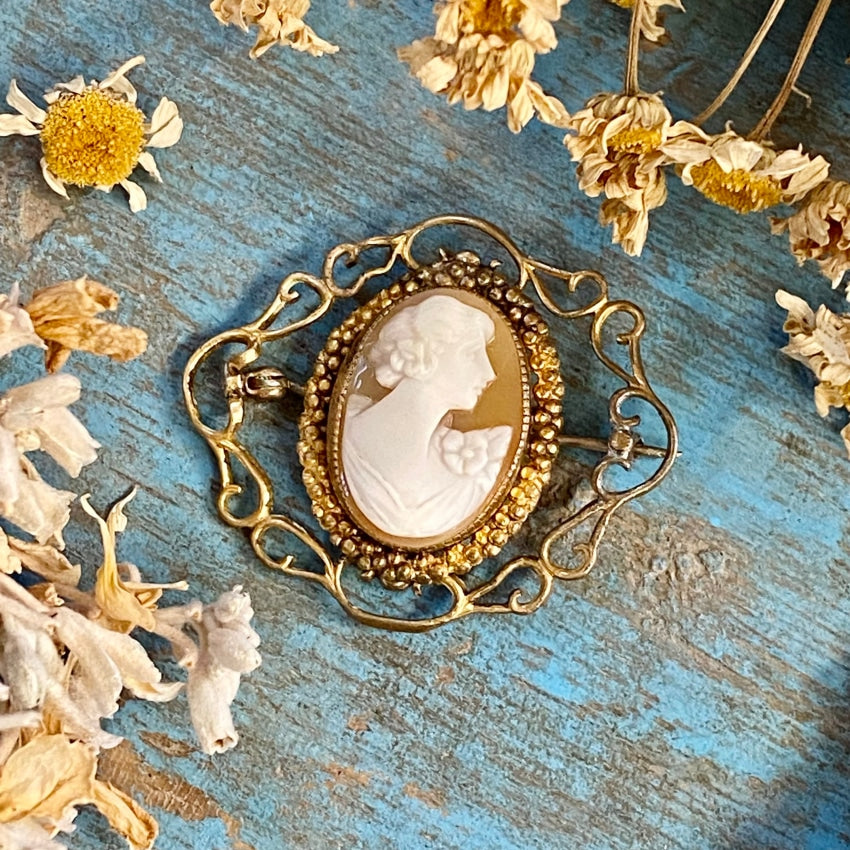Introduction
Victorian cameo brooches were popular fashion accessories during the Victorian era, which spanned from 1837 to 1901. They were typically made of gold or silver and featured a carved portrait or figure on a shell, stone, or coral background. The intricate designs and detailed craftsmanship of these brooches made them highly sought after by women of the era.
Cameo brooches were often considered a status symbol and were worn by women of all ages and social classes. They were seen as a sign of femininity and refinement, and were often given as gifts to signify love and affection. The delicate beauty of the carvings and the ornate settings of these brooches made them an essential part of Victorian fashion.
The Victorian era was a time of refined elegance, intricate design, and ornate fashion. During this period, certain accessories became synonymous with the societal norms and cultural values of the time. One such accessory is the Victorian cameo brooch, a timeless piece of jewelry. It has captivated the hearts of collectors and fashion enthusiasts for centuries. In this comprehensive guide, we will explore the history, significance. And we will delve into the enduring appeal of the Victorian cameo brooch.
Part 1: The History of the Victorian Cameo Brooch
Level 1: Origins and Evolution
The Victorian cameo brooch traces its origins back to ancient Greece and Rome, where carved gemstones and shells were used to create intricate portraits and scenes. During the Victorian era, cameo brooches gained popularity as a symbol of status and refinement, with women from all walks of life adorning themselves with these delicate accessories.
Level 2: Symbolism and Cultural Significance
Cameo brooches were not merely decorative pieces. They often held deep symbolism and cultural significance. The images and motifs depicted in cameo brooches were often associated with themes of love, beauty, and mythology. And serving as a means of self-expression for the wearer.
Part 2: The Craftsmanship of Victorian Cameo Brooches
Level 1: Materials and Techniques
Victorian cameo brooches were crafted using a variety of materials. Including shell, lava, coral, and precious gemstones such as agate and onyx. Skilled artisans would meticulously carve and polish these materials to create intricate designs and detailed portraits. Showcasing their expertise in the art of cameo carving.
Level 2: Artistry and Aesthetics
The craftsmanship of Victorian cameo brooches was revered for its attention to detail and fine artistry. Each piece was a testament to the skill and creativity of the artisan, with many brooches featuring lifelike portraits, elaborate motifs, and intricate border designs.
Part 3: The Popularity of Victorian Cameo Brooches
Level 1: Fashion and Trends
During the Victorian era, cameo brooches became a staple accessory for women of all ages. They were worn as part of everyday attire, as well as for special occasions and formal events. Serving as a timeless addition to a lady’s ensemble.
Level 2: Collectibility and Investment Value
In modern times, Victorian cameo brooches have become highly sought after by collectors and enthusiasts. Due to their intricate craftsmanship and historical significance, these brooches hold considerable investment value, with rare and exceptional pieces commanding significant prices at auctions and antique markets.
Part 4: The Enduring Appeal of Victorian Cameo Brooches
Level 1: Timeless Elegance
Despite the passage of time, Victorian cameo brooches continue to exude an air of timeless elegance and sophistication. Their intricate designs and classical motifs have ensured that they remain a coveted accessory for those who appreciate vintage and antique jewelry.
Level 2: Versatility and Wearability
The enduring appeal of Victorian cameo brooches lies in their versatility and wearability. Whether paired with a formal gown, a casual blouse, or a structured blazer, these brooches effortlessly complement a wide range of outfits, adding a touch of vintage charm to any look.
Part 5: Caring for Victorian Cameo Brooches
Level 1: Maintenance and Preservation
To ensure the longevity of Victorian cameo brooches, proper care and maintenance are essential. It is important to store these delicate pieces in a cool, dry place and avoid exposing them to direct sunlight or harsh chemicals. Periodic cleaning with a soft cloth and mild soap can help maintain the luster and beauty of the brooch.
Level 2: Professional Restoration
In the event that a Victorian cameo brooch requires restoration or repair. It is advisable to seek the expertise of a professional jeweler or antique restoration specialist. Attempting to fix or clean these intricate pieces without the necessary knowledge and tools can result in irreparable damage.
Part 6: Historical Significance
The Victorian cameo brooch holds significant historical value as it was a popular fashion accessory during the Victorian era. Particularly during the reign of Queen Victoria. These brooches were often intricately carved out of materials such as shell, coral, or precious stones and were adorned by women of all social classes. The craftsmanship and attention to detail that went into creating these brooches were highly esteemed during this time. Making them coveted pieces of jewelry.
Part 7: Symbolism
The Victorian cameo brooch often featured classical motifs and symbols that held special meanings. For example, a cameo carved with the profile of a woman could symbolize beauty and femininity, while a depiction of a mythological figure or a scene from ancient history could represent virtues such as strength, wisdom, or love. These symbolic representations added an extra layer of significance to the brooches, making them not only fashionable accessories but also meaningful expressions of the wearer’s values and beliefs.
Part 8: Modern Resurgence
In recent years, there has been a resurgence of interest in Victorian cameo brooches, with vintage and antique pieces becoming highly sought after by collectors and fashion enthusiasts. Many contemporary jewelry designers have also drawn inspiration from the Victorian era. Creating modern interpretations of the classic cameo brooch using a variety of materials and styles. This renewed appreciation for Victorian cameo brooches has ensured that these timeless accessories continue to captivate and inspire generations to come.
Conclusion
The most common material of cameo brooches during the Victorian era was carved shell. Natural shell cameos were first produced in Italy during the 15th and 16th centuries which, due to their delicate and detailed craftsmanship, made them highly prized by aristocrats and elite members of society. In the 19th century, through advances in technology and transportation, these amazing pieces of art came to the attention of women around the world.
The popularity of cameo brooches declined after the Victorian era, but they have experienced a resurgence in recent years. Many people now appreciate the historical and aesthetic significance of these beautiful pieces of jewelry. Antique Victorian cameo brooches are highly sought after by collectors. The modern reproductions are also popular among those who appreciate vintage styles. These brooches continue to be a favored accessory for formal occasions, such as weddings and other special events, adding a touch of elegant and timeless sophistication to any outfit.
The Victorian cameo brooch holds a special place in the world of vintage and antique jewelry. Symbolizing the elegance, artistry, and cultural significance of the Victorian era. From its ancient origins to its enduring appeal in modern times, the cameo brooch continues to be a prized and cherished accessory, captivating the hearts of collectors and enthusiasts with its timeless charm and beauty. Whether worn as a fashion statement or treasured as a valuable heirloom. The Victorian cameo brooch remains a testament to the enduring legacy of craftsmanship and artistry from a bygone era.



